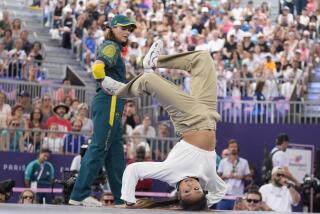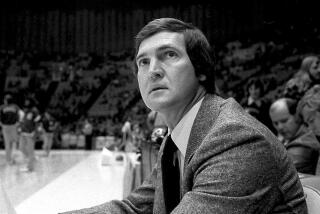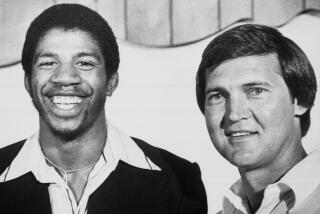NBA Finals: Lakers vs. Bulls : Building a Better Bullclub : Bulls’ General Manager Jerry Krause Took Abuse for Moves and Non-Moves, but Now He’s Looking Good
CHICAGO — Jerry Krause is easy to spot during the NBA finals. He’s the guy getting fitted for a championship ring while ducking the rotten tomatoes his hometown fans are hurling. He’s the short, roly-poly man who, somehow, can pass for Twiggy.
Life as a chameleon. Or as the Chicago Bulls’ vice president of basketball operations, a.k.a. general manager.
“I lost 25 pounds the last six weeks,” Krause said. “I’m still the same weight, but when we’re winning in the playoffs, it’s amazing how good-looking I get. People come up and compliment me on my diet. But if we lose, I’m going to be that fat little slob again.”
Krause grew up in Chicago and scouted for three other NBA teams, including the Lakers for two years, and four baseball franchises. Now, responsible after all those years for a little more than getting from one small town to another to check out the potential of some NCAA Division II forward, his signature is all over the league’s second-winningest team of 1990-91.
Everyone but Michael Jordan is one of Jerry’s kids, not that it wasn’t a good starting point. Along the way, he could have taken a flyer on Vlade Divac with the last of the Bulls’ three first-round picks in 1989 and instead nabbed Jeff Sanders, used the No. 6 choice of that same crop to draft All-NBA disappointment Stacey King, and cut Rod Higgins. Twice.
Along the way, too, the Bulls became championship contenders. Current starters Horace Grant and, with the help of a trade just after the draft, Scottie Pippen, came in the summer of 1987. Bill Cartwright arrived in the next off-season. John Paxson joined the team just before the start of 1985-86.
Krause, named executive of the year by his peers in 1988, boasts of early hirings of assistant coach Tex Winter and strength and conditioning consultant Al Vermeil. But the reconstruction of a team that finished below .500, at 40-42, as recently as 1986-87 started, of course, with Jordan.
“We were building around a (shooting guard),” Krause said. “That was tough to do. No team had ever done it. They tried to do it with Oscar (Robertson), but he didn’t get a championship team until Milwaukee.
“It wasn’t a gamble, because we had Michael and we weren’t going to trade him. It was something we had to do. We were faced with a challenge.”
The first piece the NBA’s future Eastern Conference champions added to Jordan was Paxson, signed as a restricted free agent from the San Antonio Spurs and destined to be the other starting guard. Then came Grant and Pippen, the starting forwards, in rapid-fire succession. A pattern was emerging.
“We wanted quick players,” Krause said. “We didn’t want players who couldn’t shoot because that would invite double-teaming of Michael. We said we have to have a shooter at every position and that we always wanted athletes. The only non-athlete I ever drafted was (Charles) Oakley, and we needed a horse at that position.”
Oakley, a power forward, was acquired in a deal with Cleveland. Keith Lee and Ennis Whatley, neither bound for success, went to the Cavaliers for Oakley and Calvin Duncan. Oakley then served a dual purpose for the Bulls: He spent three seasons as a rebounder, then was traded to the New York Knicks so Chicago could get its current starting center, Cartwright.
Cartwright went against the Bulls’ pure-athlete-only thinking, but, Krause said, “there were definitely things Bill Cartwright the man possessed that appealed to us.” The backup center, 1988 first-round pick Will Perdue, won’t set any records on your average obstacle course, but Krause insists he is a better athlete than most realize.
Cartwright also came at a time when some teams were scared off from making a major investment in him because of problems with his feet. Doubters figured that he wouldn’t stand up, literally, for the long haul, after having once played just two games over two seasons. But the Bulls, with Dave Corzine then at center, pushed ahead with the inquiries.
First, Cartwright came to Chicago so team physician John Hefferon could give him a thorough examination. Then, Krause went to Cartwright’s hotel room to speak with him. Pleased with his impression of the player’s attitude, Krause left, went back to his office and immediately called his New York counterpart, Al Bianchi, to say he wanted to do the deal.
A gamble? Cartwright, who turns 34 in July, has averaged 76 games in his three seasons as a Bull, appearing in all but three games during the 1990-91 season.
Craig Hodges was the first of the reserves to come, in a trade from the Phoenix Suns in December 1988. Next came Perdue, then King and B.J. Armstrong in the draft of 1989.
When it came to final additions to what developed as a championship contender, beyond rookie free-agent signee Scott Williams, Krause traded for Dennis Hopson to play behind Jordan, and Cliff Levingston to add depth in the front court. Hopson has been buried at the end of the bench. In midseason, when the Bulls were considering one final push for firepower before the trading deadline, Jordan was outspoken about going after Walter Davis, the Denver Nuggets’ veteran scorer.
Portland got Davis, the Trail Blazers saying part of the reason they made the deal was to keep him from San Antonio and Chicago, potential playoff opponents mentioned in trade rumors.
Jordan got more outspoken, saying this team would be better off with him as general manager.
Krause got more defensive.
“I’m sure he said it,” Krause said. “We didn’t trade for Walter Davis, and he was frustrated about it one day. But that day, I didn’t have time to tell him that we took a vote among the coaching staff and it was 6-0 not to trade for him.”
Now, Krause just waits to see if his moves, or non-moves, will be vindicated.
“I just steered a boat,” he said. “I don’t worry about credit. The only credit I want is a ring.”
More to Read
All things Lakers, all the time.
Get all the Lakers news you need in Dan Woike's weekly newsletter.
You may occasionally receive promotional content from the Los Angeles Times.







